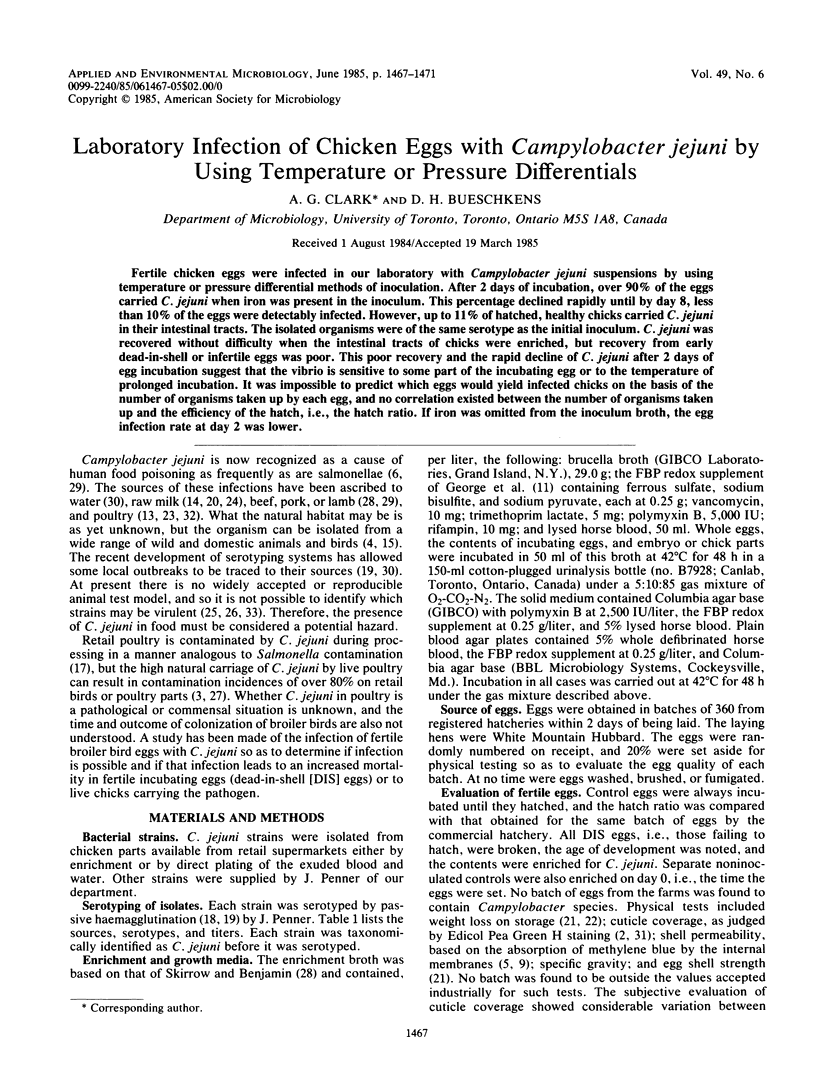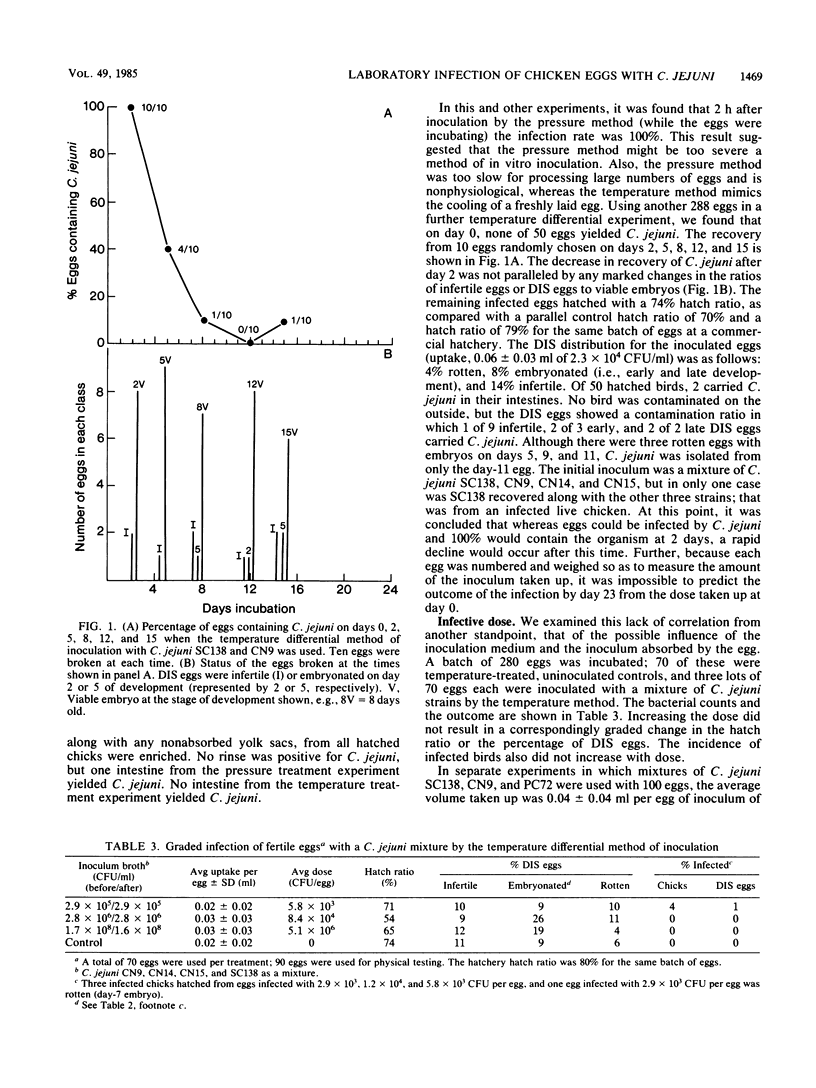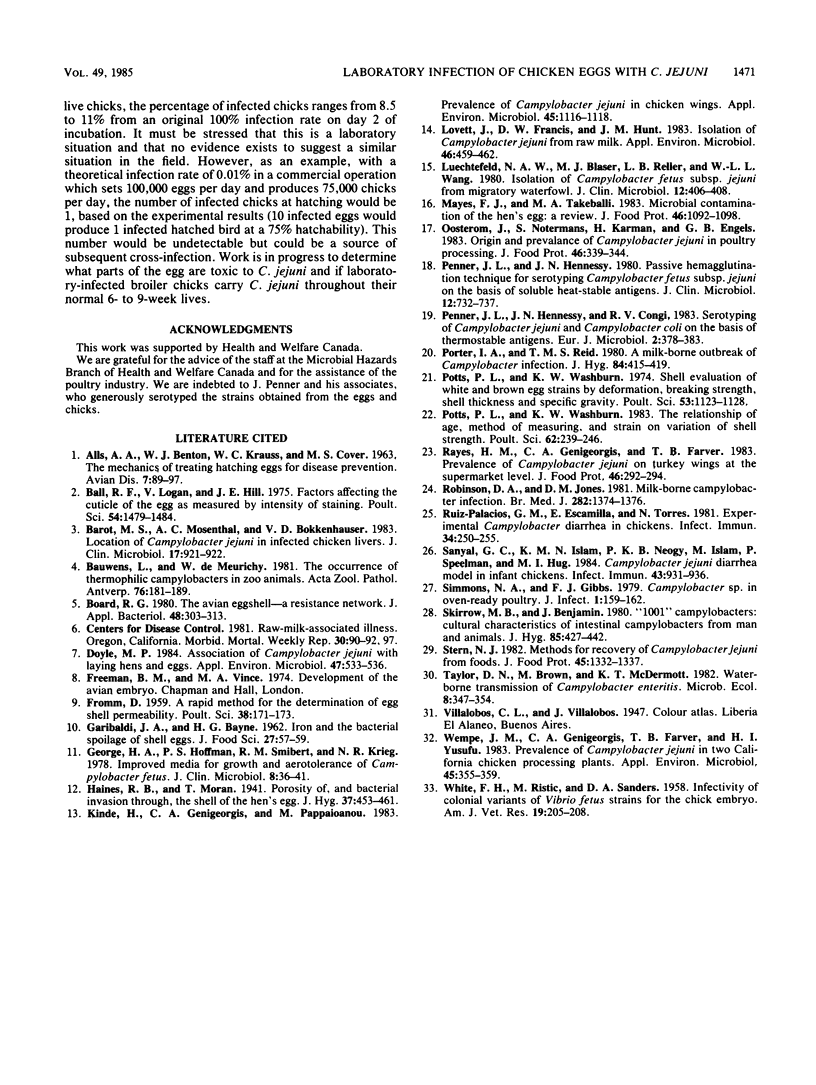Abstract
Fertile chicken eggs were infected in our laboratory with Campylobacter jejuni suspensions by using temperature or pressure differential methods of inoculation. After 2 days of incubation, over 90% of the eggs carried C. jejuni when iron was present in the inoculum. This percentage declined rapidly until by day 8, less than 10% of the eggs were detectably infected. However, up to 11% of hatched, healthy chicks carried C. jejuni in their intestinal tracts. The isolated organisms were of the same serotype as the initial inoculum. C. jejuni was recovered without difficulty when the intestinal tracts of chicks were enriched, but recovery from early dead-in-shell or infertile eggs was poor. This poor recovery and the rapid decline of C. jejuni after 2 days of egg incubation suggest that the vibrio is sensitive to some part of the incubating egg or to the temperature of prolonged incubation. It was impossible to predict which eggs would yield infected chicks on the basis of the number of organisms taken up by each egg, and no correlation existed between the number of organisms taken up and the efficiency of the hatch, i.e., the hatch ratio. If iron was omitted from the inoculum broth, the egg infection rate at day 2 was lower.
Full text
PDF




Selected References
These references are in PubMed. This may not be the complete list of references from this article.
- Alls A. A., Benton W. J., Kauss W. C., Cover M. S. The mechanics of treating hatching eggs for disease prevention. Avian Dis. 1963 Feb;7(1):89–97. [PubMed] [Google Scholar]
- Barot M. S., Mosenthal A. C., Bokkenheuser V. D. Location of Campylobacter jejuni in infected chicken livers. J Clin Microbiol. 1983 May;17(5):921–922. doi: 10.1128/jcm.17.5.921-922.1983. [DOI] [PMC free article] [PubMed] [Google Scholar]
- Doyle M. P. Association of Campylobacter jejuni with laying hens and eggs. Appl Environ Microbiol. 1984 Mar;47(3):533–536. doi: 10.1128/aem.47.3.533-536.1984. [DOI] [PMC free article] [PubMed] [Google Scholar]
- George H. A., Hoffman P. S., Smibert R. M., Krieg N. R. Improved media for growth and aerotolerance of Campylobacter fetus. J Clin Microbiol. 1978 Jul;8(1):36–41. doi: 10.1128/jcm.8.1.36-41.1978. [DOI] [PMC free article] [PubMed] [Google Scholar]
- Kinde H., Genigeorgis C. A., Pappaioanou M. Prevalence of Campylobacter jejuni in chicken wings. Appl Environ Microbiol. 1983 Mar;45(3):1116–1118. doi: 10.1128/aem.45.3.1116-1118.1983. [DOI] [PMC free article] [PubMed] [Google Scholar]
- Lovett J., Francis D. W., Hunt J. M. Isolation of Campylobacter jejuni from raw milk. Appl Environ Microbiol. 1983 Aug;46(2):459–462. doi: 10.1128/aem.46.2.459-462.1983. [DOI] [PMC free article] [PubMed] [Google Scholar]
- Luechtefeld N. A., Blaser M. J., Reller L. B., Wang W. L. Isolation of Campylobacter fetus subsp. jejuni from migratory waterfowl. J Clin Microbiol. 1980 Sep;12(3):406–408. doi: 10.1128/jcm.12.3.406-408.1980. [DOI] [PMC free article] [PubMed] [Google Scholar]
- Penner J. L., Hennessy J. N., Congi R. V. Serotyping of Campylobacter jejuni and Campylobacter coli on the basis of thermostable antigens. Eur J Clin Microbiol. 1983 Aug;2(4):378–383. doi: 10.1007/BF02019474. [DOI] [PubMed] [Google Scholar]
- Penner J. L., Hennessy J. N. Passive hemagglutination technique for serotyping Campylobacter fetus subsp. jejuni on the basis of soluble heat-stable antigens. J Clin Microbiol. 1980 Dec;12(6):732–737. doi: 10.1128/jcm.12.6.732-737.1980. [DOI] [PMC free article] [PubMed] [Google Scholar]
- Porter I. A., Reid T. M. A milk-borne outbreak of Campylobacter infection. J Hyg (Lond) 1980 Jun;84(3):415–419. doi: 10.1017/s0022172400026942. [DOI] [PMC free article] [PubMed] [Google Scholar]
- Robinson D. A., Jones D. M. Milk-borne campylobacter infection. Br Med J (Clin Res Ed) 1981 Apr 25;282(6273):1374–1376. doi: 10.1136/bmj.282.6273.1374. [DOI] [PMC free article] [PubMed] [Google Scholar]
- Ruiz-Palacios G. M., Escamilla E., Torres N. Experimental Campylobacter diarrhea in chickens. Infect Immun. 1981 Oct;34(1):250–255. doi: 10.1128/iai.34.1.250-255.1981. [DOI] [PMC free article] [PubMed] [Google Scholar]
- Sanyal S. C., Islam K. M., Neogy P. K., Islam M., Speelman P., Huq M. I. Campylobacter jejuni diarrhea model in infant chickens. Infect Immun. 1984 Mar;43(3):931–936. doi: 10.1128/iai.43.3.931-936.1984. [DOI] [PMC free article] [PubMed] [Google Scholar]
- Skirrow M. B., Benjamin J. '1001' Campylobacters: cultural characteristics of intestinal campylobacters from man and animals. J Hyg (Lond) 1980 Dec;85(3):427–442. doi: 10.1017/s0022172400063506. [DOI] [PMC free article] [PubMed] [Google Scholar]
- WHITE F. H., RISTIC M., SANDERS D. A. Infectivity of colonial variants of Vibrio fetus strains for the chicken embryo. Am J Vet Res. 1958 Jan;19(70):205–208. [PubMed] [Google Scholar]
- Wempe J. M., Genigeorgis C. A., Farver T. B., Yusufu H. I. Prevalence of Campylobacter jejuni in two California chicken processing plants. Appl Environ Microbiol. 1983 Feb;45(2):355–359. doi: 10.1128/aem.45.2.355-359.1983. [DOI] [PMC free article] [PubMed] [Google Scholar]


